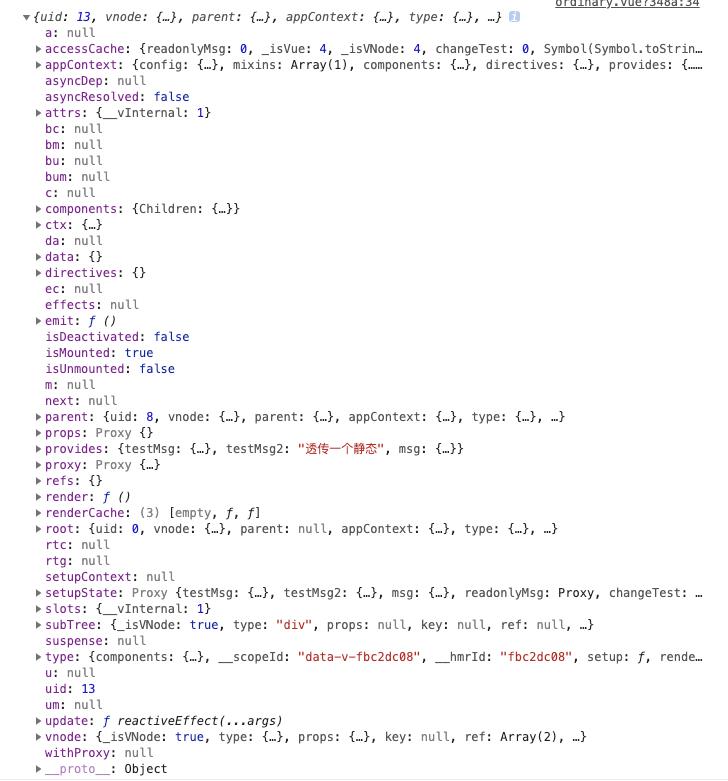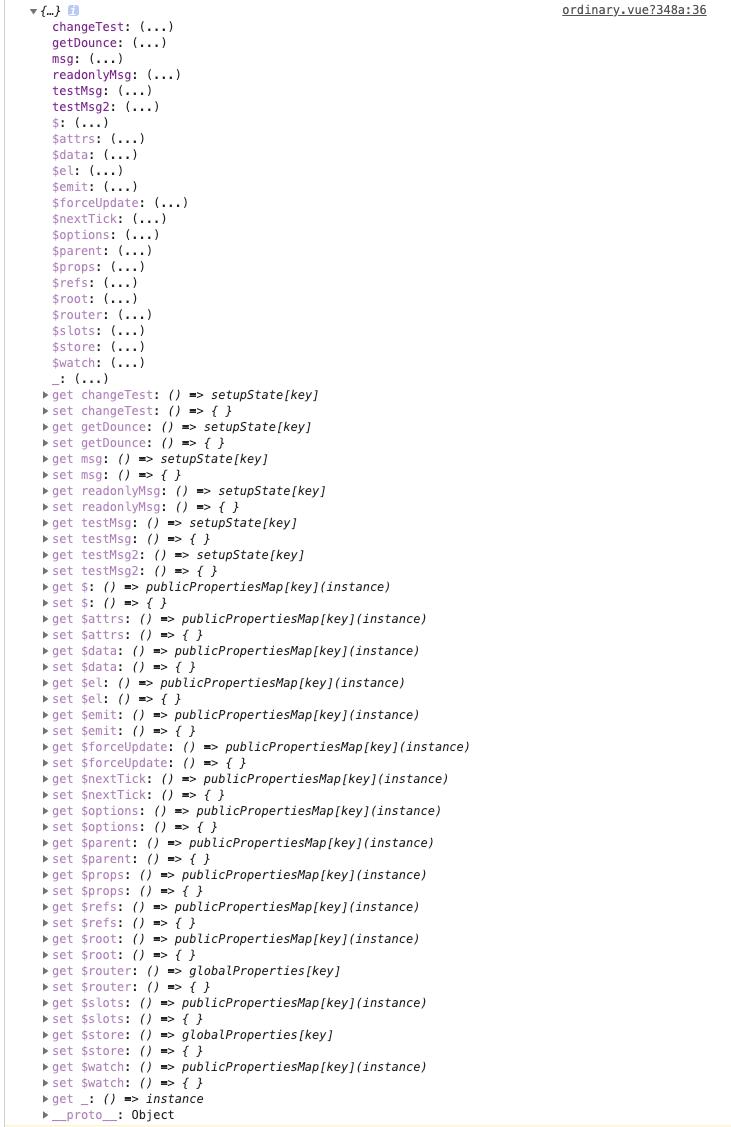vue3.0提前了解系列----一些普通用法和api的使用
Posted 金振宗
tags:
篇首语:本文由小常识网(cha138.com)小编为大家整理,主要介绍了vue3.0提前了解系列----一些普通用法和api的使用相关的知识,希望对你有一定的参考价值。
今天给大家说说vue3.0 composition api里面一些剩余的普通api的使用
provide & inject
provide和inject用于在一些高阶组件中常用,在2.x中也有一样的api那么在compositionapi中怎么用呢?
仅需要
import { provide } from \'vue\'
setup () {
provide("msg", \'透传一段数据\')
}
import { inject } from \'vue\'
setup() {
const testMsg = inject("msg")
}
如果需要传递一些响应式的我们可以这么做
<template>
<div>
<children></children>
<button @click="changeTest">
修改透传数据
</button>
</div>
</template>
<script>
import {
provide,
ref,
reactive,
toRef,
toRefs,
} from \'vue\'
import Children from \'./ordinaryChild\'
export default {
components: {
Children
},
setup() {
const msg = ref(0)
const state = reactive({
testMsg: \'测试往下透传一个数据\',
testMsg2: \'透传一个静态\'
})
const changeTest = () => {
state.testMsg = \'修改了数据\'
msg.value++
}
provide("testMsg", toRef(state, \'testMsg\'))
provide("testMsg2", state.testMsg2)
provide("msg", msg)
return {
...toRefs(state),
changeTest,
msg,
}
}
}
</script>
孙子/子组件接收
<template> <div> {{ testMsg }} </div> <div> {{ testMsg2 }} </div> <div> {{ msg }} </div> </template> <script> import { inject } from \'vue\' export default { setup() { const testMsg = inject("testMsg") const testMsg2 = inject("testMsg2") const msg = inject("msg") return { testMsg, testMsg2, msg } } } </script> <style scoped> </style>
readonly
顾名思义是一个只读属性,他接受一个对象(响应的或普通的)或一个ref,并将只读代理返回给原始代理。只读代理很深:访问的任何嵌套属性都将是只读的。使用如下:
import { readonly } from \'vue\'
const msg = ref(0)
const readonlyMsg = readonly(msg)
不过不知道是为什么,也许是我使用有问题,也许是vue就这么设计的,当我修改这个readonly对象的时候,并没有禁止我使用,只是抛出一个警告

如果是我使用有问题,还望大佬们指点下
getCurrentInstance
这是一个很重要的方法!getCurrentInstance 方法获取当前组件的实例,然后通过 ctx 属性获得当前上下文,这样我们就能在setup中使用router和vuex了 使用如下:
import { getCurrentInstance } from \'vue\'
const instance = getCurrentInstance()
console.log(instance)
const { ctx } = getCurrentInstance()
console.log(ctx)
让我们来看下分别输出什么吧
intance

ctx

通过这个属性我们就可以操作变量、全局属性、组件属性等等,总之很重要,收藏吧!
一些判断数据的方法
包含四个:
<template>
<div>
<children></children>
只读数据 : {{ readonlyMsg }}
<button @click="changeTest">
修改透传数据
</button>
<button @click="getDounce">
获取数据类型判断
</button>
</div>
</template>
<script>
import {
provide,
ref,
reactive,
toRef,
toRefs,
getCurrentInstance,
readonly,
isProxy,
isRef,
isReactive,
isReadonly,
} from \'vue\'
import Children from \'./ordinaryChild\'
export default {
components: {
Children
},
setup() {
const instance = getCurrentInstance()
console.log(instance)
const { ctx } = getCurrentInstance()
console.log(ctx)
const msg = ref(0)
const state = reactive({
testMsg: \'测试往下透传一个数据\',
testMsg2: \'透传一个静态\'
})
const readonlyMsg = readonly(msg)
const changeTest = () => {
state.testMsg = \'修改了数据\'
msg.value++
// 会发出警告 failed: target is readonly.
readonlyMsg.value++
}
const getDounce = () => {
console.log(\'isRef可以检测ref、readonly的ref数据、toRef的reactive\\r\\n\', isRef(msg), isRef(readonlyMsg), isRef(state), isRef(state.testMsg), isRef(toRef(state, \'testMsg\')))
console.log(\'isProxy可以检测readonly的数据、reactive声明的对象\\r\\n\', isProxy(msg), isProxy(readonlyMsg), isProxy(state), isProxy(state.testMsg), isProxy(toRef(state, \'testMsg\')))
console.log(\'isReactive可以检测reactive声明的对象\\r\\n\', isReactive(msg), isReactive(readonlyMsg), isReactive(state), isReactive(state.testMsg), isReactive(toRef(state, \'testMsg\')))
console.log(\'isReadonly可以检测readonly的数据\\r\\n\', isReadonly(msg), isReadonly(readonlyMsg), isReadonly(state), isReadonly(state.testMsg), isReadonly(toRef(state, \'testMsg\')))
}
provide("testMsg", toRef(state, \'testMsg\'))
provide("testMsg2", state.testMsg2)
provide("msg", msg)
return {
...toRefs(state),
changeTest,
msg,
readonlyMsg,
getDounce
}
}
}
</script>
<style scoped>
</style>
ordinary.vue
<template> <div> {{ testMsg }} </div> <div> {{ testMsg2 }} </div> <div> {{ msg }} </div> </template> <script> import { inject } from \'vue\' export default { setup() { const testMsg = inject("testMsg") const testMsg2 = inject("testMsg2") const msg = inject("msg") return { testMsg, testMsg2, msg } } } </script> <style scoped> </style>
好了 本期 分享差不多了,到现在为止。应该基础api和属性应该都全了,后期发现在补充吧,compositionapi还剩下最后一章了,今天晚上吧 我一起更新了,主要是jsx、markRaw之类的,我也是新接手vue3,如果有哪里不对或者遗漏的,还望大家指出,祝大家前端路越走越宽
以上是关于vue3.0提前了解系列----一些普通用法和api的使用的主要内容,如果未能解决你的问题,请参考以下文章